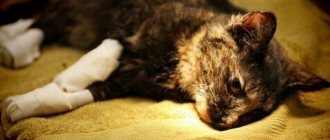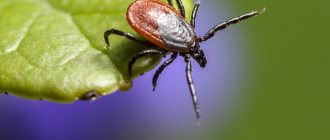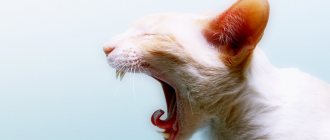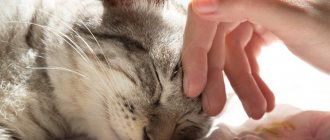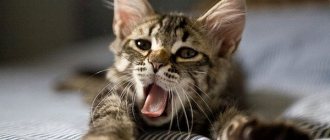The reasons why pododermatitis develops in cats are varied, so in order to cure this disease, you must first find and eliminate the original source of the problem. If your cat has sores on the paw pads that bleed and do not go away for a long time, you should not hesitate to visit the veterinarian, as untimely treatment leads to serious consequences.
Causes and risk factors
Until now, the exact root causes of this disease of cat paws have not been clarified. It is assumed that the trigger for the development of pathology may be a decrease in immunity and activation of opportunistic microflora. This includes various types of bacteria and fungi. While the immune system copes with the load, microorganisms are in a latent state, but at the slightest failure they are activated, causing various diseases, including pododermatitis.
Another suspected reason is negative environmental factors. Diseases of the paws and fingers often appear on cold days when there is severe frost outside. In such conditions, the paw pads freeze, peel, and then crack. Often contact with chemicals used to combat snow and ice causes wounds on unprotected pads. The sore can also occur due to the introduction of a strong allergen into the cat’s body. A.N. Gehrke, Ph.D., veterinary dermatologist, suggests that feline plasmacytic pododermatitis may begin to progress against the background of autoimmune disorders (vetpharma.org/articles/66/4787/). However, such a pathology is difficult to diagnose, so often the original source of the disease becomes unclear.
The risk group for developing this pathological process includes all breeds of cats, regardless of age and environmental conditions.
Cat paw print
The print of a cat's paw is round, without traces of claws, because representatives of the family walk with retracted claws that do not touch the ground. The paws leave a mark of four toes and, no matter the hind leg or the front leg, and the metacarpal soft. The two front fingers are located in close proximity to each other, while the side ones are slightly distant from the central ones. When landing a jump, a profitable fingerprint may be left behind. When pursuing prey, the tracks of the four legs come closer together.
Manifestation of the disease
As the disease progresses, sores may appear on the pads of the feet.
Normally, a healthy cat has pads on the front and hind paws (including the carpal paws), pink, smooth, and moderately dry. With pododermatitis, in the initial stages of development, the cat's paw pads increase slightly in size, but discomfort is not yet a concern, which is why it is so difficult to diagnose the pathology at stage 1. Further, the affected areas soften, their color becomes unnaturally bluish. It is difficult to notice the pathology if the seals' pads are black, but if you look closely, you will be able to notice peeling and hair falling out in the affected areas. In advanced stages, bacterial inflammation occurs; in places where the pads are cracked, red bleeding wounds appear that do not heal. The paws are hot to the touch and very dry. If the pathology is not treated, necrosis develops, which often leads to the death of the pet.
Symptomatic picture
The signs of the disease are quite eloquent - the cat’s paw pads become very swollen due to the penetration of plasma cells into the tissue. If the pads are light, then it is noticeable that they change their shade to a brighter pink with a lilac or bluish tint; on black or other dark paws, the change in color is not so noticeable or not visible at all, but severe edema, literally swelling of the pad, is always observed.
When you feel the swollen paw pads, the cat does not react, that is, the formations are not painful, but severe swelling can prevent the animal from walking normally, causing inconvenience or discomfort. Peeling of the surface of the affected pad is often observed. But with severe swelling of the tissue, the pads cannot withstand the tension and crack.
Infection penetrates into the lesions, which leads to inflammation and the appearance of purulent foci. The skin becomes covered with sores that bother the animal; the cat can constantly lick them, which can cause the spread of bacterial infection and lead to lameness of the pet.
A particular threat is posed by open damage to the tissues of animals that live in a private house and have free access to the street and the ground. If such a complication of the disease occurs, you need to keep the cat in a closed, clean room.
In some cases, the disease suddenly disappears on its own without any specialized treatment or stable remission occurs.
Diagnostic methods
If your cat's pads are cracking, and the wound is bleeding and does not heal for a long time, you should not delay a visit to the veterinarian. After the initial examination, a sample is taken from the affected area for microscopic, cytological and histological examination. The sensitivity of the identified pathogen to antibiotics is also determined.
It is important that the doctor distinguishes the animal’s disease from pemphigus foliaceus in time.
There are other dangerous diseases in which the paw pads peel off and become an unnatural color. Therefore, differential diagnosis must be carried out, which will help exclude such pathologies:
- eosinophilic granuloma;
- neoplasia;
- pemphigus foliaceus;
- injury.
Pads to survive
Our beloved cats tiptoe through life. And the point is not in the beauty and grace of such a gait - people with mustaches hardly think about this. Simply walking and running on your toes increases the chances of a successful hunt - thus the swing becomes longer and the speed is higher.
In addition, the pads work as sound absorbers - it’s not without reason that they say: she walked in quietly, like a cat. The pads soften both the sound of a jump and the sound of a step, which is especially important when hunting. A cat that sneaks around on tiptoe is very difficult for potential prey to notice!
The small paw pads contain a large number of nerve endings that help assess temperature and surface texture, as well as sense unevenness, which helps maintain balance.
Also, these nerve endings very sensitively pick up the slightest vibration - this is what is associated with the ability of cats, and many other animals, to “predict” earthquakes. There is nothing mystical here; cats begin to show anxiety several hours before the first tremors, as they sense the slight vibration of the soil that precedes it.
How to treat?
Drug treatment
If the pads on a cat’s paws are dry, severely cracked, and due to bleeding sores the animal cannot move normally, complex drug treatment is prescribed. The following groups of drugs are used:
- Systemic glucocorticosteroids. Reduce the manifestation of the disease, eliminate inflammation. The dosage is determined by the doctor taking into account the weight and age of the cat. The following drugs are used: Prednisolone;
- "Methylprednisolone."
- "Doxycycline";
To increase immunity, immunostimulating agents, vitamins, mineral complexes, and dietary supplements are prescribed.
Surgical
Sometimes the animal's recovery depends on the operation.
Sometimes drug treatment does not bring results. The pads remain modified and deformed. As a result, the animal cannot move normally, as the enlarged tissues interfere. In this case, the doctor will advise removing the affected area. After surgery, pododermatitis completely disappears without the use of medications.
When the phenomenon is observed
The owner most often observes the peculiar behavior of a domestic cat when the animal is in a peaceful and calm state. At this moment, the pet may purr. Some cats perform the ritual without releasing their claws. Other individuals can crush the soft surface, extending their claws to their full length. At the same time, the animal looks concentrated, the reaction to external stimuli becomes minimal. Some owners compare this state of their pet to nirvana.
Many cat breeders note that the cat ritual usually takes place on a soft and pliable surface: a blanket, a mattress, the owner’s lap. A hard surface is not suitable for such purposes. Often the “milk step” is used in relation to a soft toy.
Most often, a cat crushes a soft object with its paws when it is about to rest or sleep. Expectant mothers begin to prepare the nest for childbirth and offspring, often before an important event they begin to knead the blanket with their paws. Pets love to perform such a mysterious action when they are on the lap of their beloved owner. Fans of cats note that a cat performs such a ritual only with its owner; such affection is not available to a stranger.
To learn about what a “milk step” is in cats, watch this video:
Prevention
To prevent the development of pododermatitis, it is important to constantly examine the animal’s paws, even if the cat is black, the disease will be visible by peeling and unnatural dryness. As a preventive measure, it is recommended to wash the cat’s paws with disinfectants, not let him go outside during the cold season, and increase the body’s protective functions. If there are characteristic symptoms, do not self-medicate, but urgently take your pet to the hospital. If diagnosis and treatment are timely, complications can be avoided.
Thermoregulation pads
You won't find a cat with sweaty armpits anywhere! And not because cats don’t sweat—every living creature needs a thermoregulation mechanism. They just sweat through their paw pads. Those who have visited the veterinarian with their pet have probably noticed small paw prints on the examination table.
This means that the tailed friend has experienced not the most pleasant moments in his life. However, cats do not only sweat during times of stress. On hot days, this “cooling system” helps avoid overheating.
Rules for treating wounds at home
What to do at home if your pet comes home with an abrasion:
- Open the wound surface for easier access: cut the hair around the injury, remove stuck foreign objects (clumps of hair, leaves, grass) with tweezers, wash the edges if they are dirty (it is better to rinse with a sponge in the direction from the center of the wound outward). If cutting is not possible, use a damp sponge to spread the hair to the sides.
- Treat the wound (first, the cat is given an antiseptic for primary disinfection, then a drug to speed up healing).
- Cover the wound with clean napkins or bandage it to prevent licking and contamination with pathogenic microflora.
- Put a protective collar on the cat (this will prevent it from licking and pulling off the bandage on its own).
- Provide rest to the pet and do not let it go for a walk until healing is evident.
If you need to treat a cat’s deep bleeding wound at home, you need to do the following:
- pack the injury site with gauze and, if possible, apply a tourniquet (if the bleeding is intense);
- clean the wound of foreign objects;
- treat the edges of the wound with an antiseptic solution;
- cover the injured surface with a clean cloth or gauze;
- deliver the animal to the veterinary center.
Superficial
Superficial wounds in cats include abrasions, scratches, and first-degree burns (redness and increased local temperature). Common places: on the cat's head, ears, neck and sides.
Such injuries in cats heal quite quickly (5-7 days), do not require stitches and do not leave scars. However, it is necessary to treat them to prevent suppuration (especially if the animal roams freely and the weather is warm).
How can you treat, anoint and sprinkle on superficial wounds on a cat:
| Primary processing | Secondary (to speed up healing) |
| Hydrogen peroxide | Aluminumspray |
| Diamond green | Saphroderm gel (for burns) |
| Chlorhexidine | Sangel |
| Vetericin | Ranosan powder |
| Terramycin spray | Tsamaks powder |
| Chemisprey | Levomekol veterinary |
| Second skin (bandage spray) |
Among the medical means for wound healing, the following are suitable for cats:
- Levomekol ointment;
- Syntomycin ointment.
Important! In no case should you use alcohol tinctures, alcohol or iodine. These agents cause additional burns to the edges of the wound and slow down the healing process. In addition, they cause severe pain to the cat during procedures. Vishnevsky ointment is also prohibited for use due to its high toxicity.
If after treatment the wound does not heal within several days, it is probably located in the area where the skin is stretched and is injured by the animal itself (the tongue) during movements. In this case, it is advisable to apply a greasy ointment (Levomekol) and apply a bandage or protective collar to the pet.
The main principles in the treatment of any wounds: dry - moisten and moisturize with solutions and ointments (to avoid cracks and scars), wet and weeping - dry with powders (so as not to blur the edges with the resulting tissue granulation).
Deep
At home, deep lacerations in cats are treated according to the same principle: stopping bleeding, cleaning and sanitizing the injured surface, then filling the wound surface with an ointment that stimulates healing (with the active substance - methyluracil).
Stop bleeding in a cat correctly using tamponade (filling the wound cavity with gauze pads), hemostatic sponges (injected into the bleeding area and, if necessary, left there as it resolves).
If the cat owner sees the need for sutures, then after initial treatment the damage should be covered with a sterile bandage and the pet taken to the veterinarian. He will sutured the edges of the wound surface layer by layer, install drainage to remove moisture and give further recommendations.
As a rule, antibiotics are always present in the treatment of deep wounds (Cobactan, Sinulox, Amoxicillin). They prevent complications such as suppuration and accelerate the scarring process.
If the reason for the formation of a deep wound is a tumor that has opened (with an existing cancer), then it is necessary to treat the open surface daily (2-3 times a day) until the problem is resolved.
Suitable agents are Chlorhexidine, Hydrogen Peroxide or Furacilin solution. After sanitation, be sure to cover the wound surface with gauze to avoid aggravating the process.
Important! Cut and gunshot wounds must be sutured in a hospital hospital setting, where it is important to deliver the cat as soon as possible. The veterinarian will put the animal under general anesthesia and perform the necessary surgical procedures.
It may be necessary to leave the cat for several days in the clinic's hospital for IV drips to monitor the pet's condition around the clock.
Purulent
The most unpleasant wounds in veterinary dermatology are purulent ones. Due to the overlay of pathological microflora, the process of formation of gray-green pus begins, and an unpleasant odor occurs.
If the course is prolonged in free-living cats, insects can penetrate into an open purulent wound, which will cleanse the wound of exudate, but will not allow it to heal. The result is a very unpleasant picture - a deep, non-healing wound with an abundance of living fly larvae (which feed on dead cells).
With this form of flow, it is necessary to clean the cavity from larvae (with tweezers), treat with solutions and ointments to stimulate healing. It is optimal to use Chlorhexidine and Levomekol.
If the purulent process is closed (a ripening abscess after an abrasion received during a fight between cats, which most often forms on the head, cheeks and in the ear area), then there are two possible outcomes:
- Wait until the abscess matures and spontaneously opens, the contents flow out.
- Take the fighter to the veterinarian, who will open the cavity promptly.
In any case, the cavity treatment process will be the same:
- squeeze out the remaining pus;
- rinse generously with Chlorhexidine or Furacilin (Hydrogen peroxide will produce abundant foam and increase the procedure time);
- install drainage (if the wound is not completely sutured) to ensure the outflow of new exudate;
- filling the cavity with ointment using a large syringe (Levomekol or Ranosan);
- distribute the ointment evenly under the skin;
- closing the cavity opening with gauze;
- change the bandage daily, clean the wound, rinse and introduce a new portion of ointment (course 3-4 days).
Additionally, the doctor may prescribe broad-spectrum antibiotics in the form of injections (Betamax, Cobactan, Amoxicillin, Sinulox) for a course of 3-7 days.
It is necessary to treat purulent wounds in uncastrated cats quite often due to their character traits and constant struggle for territory, so it is better for owners of such pets to always have any liquid antiseptic and wound-healing ointment in their first aid kit.
The most budget-friendly and effective complex is Furacilin in tablets (a fresh solution is prepared from it) and Levomekol ointment (veterinary or medical).
According to average indicators, deep and purulent wounds heal in a period of 1 to 2 weeks. If after 3 weeks the healing process is sluggish, then treatment correction and bacteriological culture of the exudate to determine an effective antibiotic are necessary.
Sometimes, for non-healing wounds, veterinarians prescribe the human drug Pyrogenal to cats in injections. The course is determined individually.
Thai cat breed
The very first mentions of cats “white, with black ears, paws and tail” date back to the 14th-15th centuries. It was then that in the Thai kingdom of Ayutthaya a handwritten collection “The Book of Poems about Cats” was created, which exists to this day and is stored in the National Library of Bangkok.
Manuscripts of cat poems show images of a light-colored cat with contrasting dark markings. Cats similar to today's Thai cats are described under the name Wichien-Maat.
It is believed that only the royal family and Buddhist temples owned these cats. In that distant time, when myths dominated the minds of mere mortals, the Thais believed that these cats drove away evil spirits, cleansed the home of evil, and were worshiped as guardians of sacred temples and protectors of the souls of the dead. These cats, nicknamed "royal", were jealously guarded from prying eyes.
The surviving manuscripts also tell us that cats of a rare color guarded royal palaces, temples and rich libraries with valuable manuscripts from rats, mice, and snakes, without any fear of their bites. The reason for this is the specific “device” of the skin of the legendary, fearless guards. The skin of the Siamese is, as it were, worn on the body of a cat and is similar to the skin of fighting dogs. The skin is elastic, strong, and is also penetrated by a minimum number of blood vessels, has a minimum of nerve endings, which contributes to a low pain threshold, and also prevents the spread of poisons and infection due to a bite or mechanical damage to the skin. The saliva of these cats has a strong antibacterial effect. And to top it all off, cats are much more ferocious than dogs in a fight, and are just as affectionate, affectionate and devoted to a person, their owner. All these features of Siamese cats, apparently, attracted the attention of the monks, who specially
Source
